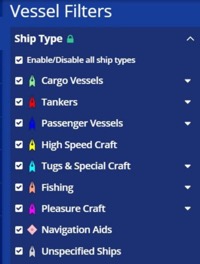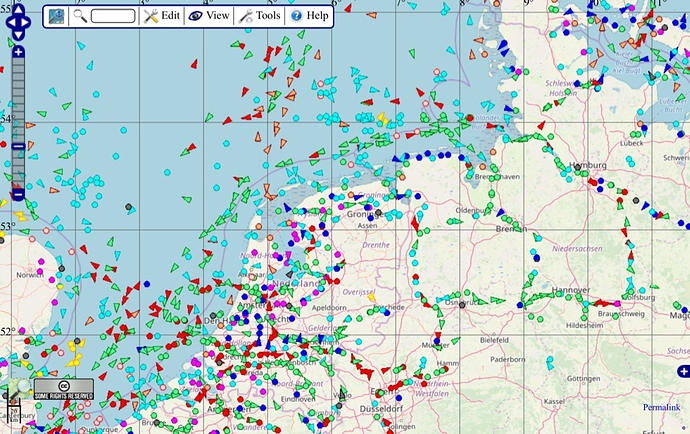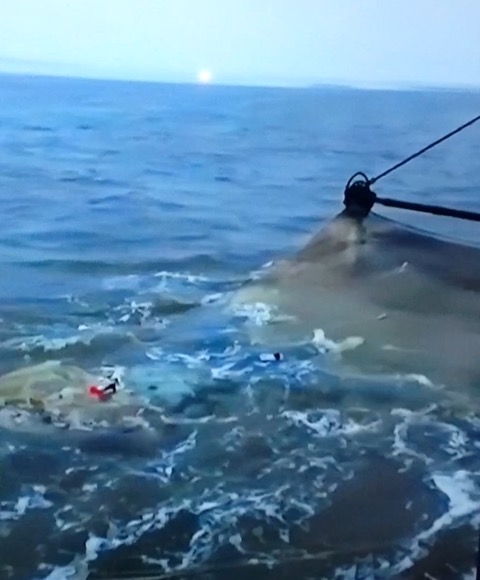I had two good experiences with passive flume stability tanks. One was an oceanographic research vessel which spent much of its time at sea drifting at sea and the other a small general cargo vessel. It was back in the days of pencil and paper and the calculations took an appreciable time on the cargo vessel . Once the tank level required was obtained the effect was so dramatic that there was complete cooperation from all hands. The bosun sounded the tank and signaled the bridge from the mast house (no radio then). The emergency telegraph rung and the duty engineer stopped the pump.
This was also discussed in post 31 of this topic.
I did some arithmetics on the accelerations which will occur at bridge level with a roll of 44° in 10 seconds. The results are I think a bit mind blowing but please correct me if I am wrong. The second mate who was able to hold on to the chart table, probably by grabbing the handrail, must have been a stout fellow because if he weighed 75 kg with that acceleration his weight would have increased to 148 kg.
The lateral forces on the containers is another matter and is depending on the weight of each container, the x, y, z coordinates with reference to the LCF and the acceleration at that position. That was an excellent lashing job what they did on this ship!
The swing along the arc at 40 m bridge height is 61.4 m. With the roll time of 10 seconds this amounts to a speed of 22.1 km/u.
I cannot make such a graph for the MSC Zoe because insufficient data is available such as the GM. For instance, with that value the roll time could be calculated. With the USCG Weather Criterion I calculated earlier a GM of 1 which is pretty low for a container ship. For the Chicago Express I calculated with the Criterion a GM of 6. The ship sailed from Hong Kong with a GM of 7.72.
IMHO she was rolling heavily and touching bottom on her starboard side causing massive decelerations that overcame the lashing. The forces generated were in excess of the design parameters.
I would like to see a side scan of the seabed along her track, no doubt it will come out in the report.
I wrote this before and as you said it is a serious possibility. Hitting the sea bottom will produce a jolt or jerk which is the rate of change of the acceleration with a short duration with a magnitude of m/s³. This can also be expressed in standard gravity per second (g/s).

I calculated the acceleration at bridge level that is caused by such a jolt as > 5 g! Anything can potentially break then…
This picture shows the different allowable values for the g forces during a rollercoaster ride.
Screenshot taken today at 13:40 GMT

The small round symbols are stationary objects such as stopped ships.
One can wonder why not more serious incidents have happened on these overcrowded routes which are also lying so close to a protected heritage area of which the polluted islands are part of. Until now 51 containers are still missing.
Also fishers are helping with the cleaning operation.
News reports yesterday in the UK of hundreds of dead birds being washed up on the shore near where the containers were lost.
The loss is far greater than thought:
The recovery operation is costly with a large fleet of vessels engaged to locate and salvage the containers and spilled cargo from the seabed:
Who knows which stow-software the MSC Zoe used prior to it recently losing containers?
So far very little information about the accident has become available to the public which leaves room for a lot of speculation. Some of the most commonly used software for ships planning are CASP, MACS3 and Bulko, could be any of these. Is there a specific reason that you want to know the stowage software used on the MSC Zoe?
2 posts were split to a new topic: Two utes valued at $300k among treasures lost in container spill
Bremerhaven suffers from the stench of 30 tons of rotting grapefruit. The nuisance started recently after the freezing weather was over. The unloaded 450 containers are still stored in one of the Container Terminal Eurogate warehouses.
According to the Habormaster Mai it is a logistic nightmare and circus with people swarming all over the place wanting to inspect the containers such as container owners, owners of goods packed in the containers and of course scores of assurance inspectors.
Since the return of the ship to Bremerhaven on 5 January the damage is repaired and a lot of welding is going on. For instance numerous twistlocks have been ripped clean out of the deck leaving behind big holes. The ship is expected to sail next week.

I am curious whether captain Domenico Pica is still in command.
If the twist locks got ripped out of the deck that would indicate the the acceleration loads far exceeded the lashing gear strength.
Might be inadequate lashing but not a poor lashing job.
I was thinking the same. Very interesting that the sockets allegedly failed before the actual twist locks.
The Dutch newspaper article’s description was rather unclear and cryptic. It could be that lashing hooks on the deck were meant and not twistlocks. On the other hand there was no confusion about the holes in the deck. One would expect that the hooks would give way earlier and before tearing holes in the deck.
In any case likely some very high loads.
I don’t know which would give higher loads, synchronous or parametric rolling. My guess is that parametric rolling would give higher loads. Also it’s more likely to catch the crew by surprise.
Captain Gunter Schütze has written an interesting analysis well worth reading also seen his nautical experience which is extensive. He suspects that parametric rolling was the cause of the accident.
I support his statement about the rather limited knowledge of this phenomenon with nautical officers although there is now a steep learning curve in view of the many occurrences going on, especially in the container ship trade.
It is often used the term “Parametric Rolling”, but it should be noted that many nautical officers, the meaning of this term and especially causes and characteristics of the parametric rolling are not known. Which means that in such situations wrong decisions may are not excluded which can cause loss of cargo, damage to the ship and even total loss of ships.
We already discussed most of his findings. Interesting is that he seemed to have received information from the board inspections that in the affected bays lashing rods were broken in large numbers. This is an indication that the container lashing was insufficiently executed in the affected bays.
He believes that the container losses and cargo damage on “MSC Zoe” would have been avoidable. If with the necessary sense of duty and due responsibility, the vessel had been prepared for the expected weather conditions.
Interesting to read are also a number of reactions to the article at the end.
Sounds like the fitting on the lashing gear were stronger that the deck that they were welded to. I’d call that a structural failure of the deck itself, not the lashing gear.
Yes, I should have said the lashing system failed.



